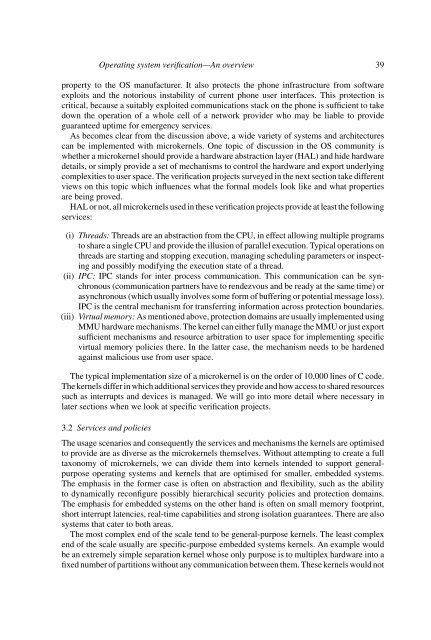Operating system verificationâAn overview
Operating system verificationâAn overview
Operating system verificationâAn overview
Create successful ePaper yourself
Turn your PDF publications into a flip-book with our unique Google optimized e-Paper software.
<strong>Operating</strong> <strong>system</strong> verification—An <strong>overview</strong> 39<br />
property to the OS manufacturer. It also protects the phone infrastructure from software<br />
exploits and the notorious instability of current phone user interfaces. This protection is<br />
critical, because a suitably exploited communications stack on the phone is sufficient to take<br />
down the operation of a whole cell of a network provider who may be liable to provide<br />
guaranteed uptime for emergency services.<br />
As becomes clear from the discussion above, a wide variety of <strong>system</strong>s and architectures<br />
can be implemented with microkernels. One topic of discussion in the OS community is<br />
whether a microkernel should provide a hardware abstraction layer (HAL) and hide hardware<br />
details, or simply provide a set of mechanisms to control the hardware and export underlying<br />
complexities to user space. The verification projects surveyed in the next section take different<br />
views on this topic which influences what the formal models look like and what properties<br />
are being proved.<br />
HAL or not, all microkernels used in these verification projects provide at least the following<br />
services:<br />
(i) Threads: Threads are an abstraction from the CPU, in effect allowing multiple programs<br />
to share a single CPU and provide the illusion of parallel execution. Typical operations on<br />
threads are starting and stopping execution, managing scheduling parameters or inspecting<br />
and possibly modifying the execution state of a thread.<br />
(ii) IPC: IPC stands for inter process communication. This communication can be synchronous<br />
(communication partners have to rendezvous and be ready at the same time) or<br />
asynchronous (which usually involves some form of buffering or potential message loss).<br />
IPC is the central mechanism for transferring information across protection boundaries.<br />
(iii) Virtual memory: As mentioned above, protection domains are usually implemented using<br />
MMU hardware mechanisms. The kernel can either fully manage the MMU or just export<br />
sufficient mechanisms and resource arbitration to user space for implementing specific<br />
virtual memory policies there. In the latter case, the mechanism needs to be hardened<br />
against malicious use from user space.<br />
The typical implementation size of a microkernel is on the order of 10,000 lines of C code.<br />
The kernels differ in which additional services they provide and how access to shared resources<br />
such as interrupts and devices is managed. We will go into more detail where necessary in<br />
later sections when we look at specific verification projects.<br />
3.2 Services and policies<br />
The usage scenarios and consequently the services and mechanisms the kernels are optimised<br />
to provide are as diverse as the microkernels themselves. Without attempting to create a full<br />
taxonomy of microkernels, we can divide them into kernels intended to support generalpurpose<br />
operating <strong>system</strong>s and kernels that are optimised for smaller, embedded <strong>system</strong>s.<br />
The emphasis in the former case is often on abstraction and flexibility, such as the ability<br />
to dynamically reconfigure possibly hierarchical security policies and protection domains.<br />
The emphasis for embedded <strong>system</strong>s on the other hand is often on small memory footprint,<br />
short interrupt latencies, real-time capabilities and strong isolation guarantees. There are also<br />
<strong>system</strong>s that cater to both areas.<br />
The most complex end of the scale tend to be general-purpose kernels. The least complex<br />
end of the scale usually are specific-purpose embedded <strong>system</strong>s kernels. An example would<br />
be an extremely simple separation kernel whose only purpose is to multiplex hardware into a<br />
fixed number of partitions without any communication between them. These kernels would not
















